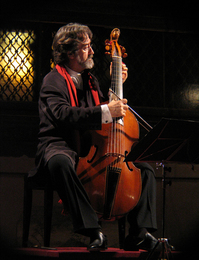Jordi Savall captivates in 'Route to the New World' performance

Jordi Savall publicity photo
In a moment typical of their seamless program at St. Francis of Assisi Catholic Church, where the groups appeared under University Musical Society auspices, they closed the show with a swift segue from 17th century baroque to Mexican traditional music, demonstrating in an instant how an underlying rhythm can be a bridge from past to present.
Certainly, rhythmic vitality was a hallmark of the evening, devoted to “The Route to the New World: Spain-Mexico.” And, having exited with these rhythms — and the sounds of voices, viols, guitars and drums of all descriptions — still dancing in my head, I bet you’d have trouble convincing tonight’s audience that there are more delightful endeavors than following this route. Or than checking out the cross-fertilization that ensued as Spanish musical forms and instruments met and mixed with those of the indigenous Indian populations and of Africans exploited as slaves. It’s a heady mix.
One of the program’s striking features was the extent to which it engaged more than just our ears. There was plenty to listen to: the wonderful timbres of the viols and guitars and percussion (amazing how rattles can imitate birdsong); the distinctive timbres of the singers, including of course, soprano Montserrat Figueras, Savall’s wife, and Ada Coronel; and of course, Savall himself, improvising astonishingly on his viola da gamba.
If much of the music is strophic and set over a repeating bass, we are never bored. The selections shift enough — from, say, lyrical or dreamy (a memorable lullaby by Figueras) to impassioned (“El Pajarillo,” sung as a speechlike outpouring by Coronel and Zenen Zeferino) — to keep the ear awake.
But so much of this program’s music is dance music that we are also engaged on a visceral level, dancing with our own bodies, and, of course, admiring the suave upright grace and zapateado footwork of Donaji Esparza, partnered elegantly and sensuously for a brief moment by bass Ivan Garcia. On a visual level, it was great fun to watch the instrumentalists play instruments I’d never encountered before, like the marimbol, a box drum with metal strips across the sound hole that are tuned to different pitches. It made a great seat for the player as well as a great sound for the audience.
Perhaps because of the visual elements, I was bothered even more than usual by the limitations of St. Francis as a concert hall, which, of course, is not its primary purpose. The sightlines are simply terrible, so that it was a trial to see the dancer’s feet or to watch Savall across the rows of people shifting this way and that in the pews to see over the people in front of them. And the torchere lighting on the stage created glare that made it even more difficult to see the singers. Maybe it wouldn’t be in harmony with early music, but I found myself wishing for big screens projecting the stage action. Old world meets new, you know?
Susan Isaacs Nisbett is a free-lance writer who covers classical music and dance for AnnArbor.com.


Comments
bedrog
Fri, Oct 1, 2010 : 6:44 a.m.
I've seen jordi savall and his various ensembles many times...and this was one of the best and most seamlessly varied performances ever. With all the carping about this and that that goes on on this site, it's worth remembering the unique cultural benefits/treasures offered by this this small, easy to get around town. 10 minutes after leaving the concert we were back in our own secluded woodland. In your face N.Y!!!